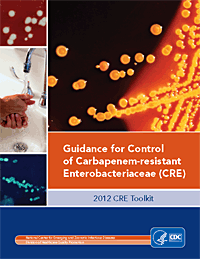Carbapenem-resistant Enterobacteriaceae (CRE)
CRE, which stands for carbapenem-resistant Enterobacteriaceae, are a family of germs that are difficult to treat because they have high levels of resistance to antibiotics. Klebsiella species and Escherichia coli (E. coli) are examples of Enterobacteriaceae, a normal part of the human gut bacteria, that can become carbapenem-resistant.
Healthy people usually do not get CRE infections. In healthcare settings, CRE infections most commonly occur among patients who are receiving treatment for other conditions. Patients whose care requires devices like ventilators (breathing machines), urinary (bladder) catheters, or intravenous (vein) catheters, and patients who are taking long courses of certain antibiotics are most at risk for CRE infections.
Some CRE bacteria have become resistant to most available antibiotics. Infections with these germs are very difficult to treat, and can be deadly—one report cites they can contribute to death in 40% of patients who become infected.
Resources for...
 Tracking CRE
Tracking CRE
CDC is working to better understand the true number of infections caused by these organisms in the US.
Get email updates
To receive email updates about this page, enter your email address:
Contact Us:
- Centers for Disease Control and Prevention
1600 Clifton Rd
Atlanta, GA 30333 - 800-CDC-INFO
(800-232-4636)
TTY: (888) 232-6348 - New Hours of Operation
8am-8pm ET/Monday-Friday
Closed Holidays - cdcinfo@cdc.gov






